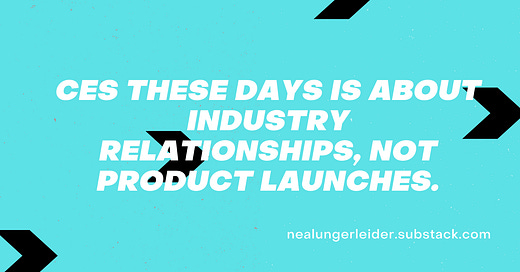CES 2021 Was A Placeholder Event. That's 1000% OK And 1000% Good.
You can't recreate trade shows with tens of thousands of attendees during a pandemic: The Neal Ungerleider Newsletter #72
So! This year’s weird, online-only CES just wrapped up and it was a success. The Consumer Technology Association, CES’ organizers, did an amazing job taking a massive, sprawling trade show and turning it into a virtual event.
CES 2021 was also a placeholder convention because it wasn’t logistically possible to create an in-person event.
These two facts aren’t contradictory. They’re complementary.
And let’s throw a third fact into the mix: CES these days is about industry relationships, not product launches.
CES Is Good For Product Launches, But Great For Dealmaking.
Once upon a time, brands would monkey knife fight each other for the opportunity to launch their products at CES.
The VCR and CD player made their debuts at the CES. Tech history is rich with high-profile product launches at CES that include the Nintendo Entertainment System, the Commodore 64, the original Microsoft Xbox and pretty much every 4G smartphone not made by Apple or Samsung.
But tech history isn’t the current tech industry. These days, the largest tech companies host their own high-profile events: Think about Apple’s WWDC, Google’s Google I/O, Adobe’s Adobe MAX and Samsung’s glossy product launches. These events, where very large companies create highly controlled environments to launch products in settings that are favorable to them, make much more sense for the biggest incumbents than launching at CES.
Other trade shows such as Mobile World Congress (smartphones and tablets) and E3 (gaming) took market share that originally belonged to CES. Back in the olden days of the 1980s and 1990s, consumer electronic technology was a market niche--after all, televisions, stereos and personal computers were a healthy chunk of consumer spending but didn’t make or break national economies. But tech runs the world now.
In 2021, tech companies like Facebook, Amazon and Google are arguably more powerful than many nation states. For CES, that means 170,000 guests attended the last in-person CES. 170,000? That’s the population of a small American city! That’s amazing for a trade show… but terrible for a company looking to get press and investor/sales deals for their new products.
The problem, product launch-wise, is that once trade shows get to a certain large size--say over 20,000 attendees--the signal-to-noise ratio from announcements made at those events declines exponentially. This isn’t due to any fault behind the trade show’s producers or organizers; it’s due to the fact that the more news is broken at an event, the harder it is to guarantee coverage and exposure.
But those ridiculous attendance numbers--170,000 attendees!--mean CES is in an enviable place when it comes to networking, dealmaking, and client and customer development. Instead of hopping on flights across the world, a sales executive for, say, LG could meet with a third of their buyers in a course of a week or so. CES is a ridiculously easy place for anyone in the consumer-facing tech industry to meet a large slice of their email contacts IRL. For smaller companies especially, booking a hotel suite for CES product demos and taking business development prospects out to dinner is a time-honored tradition for corporate growth.
You can’t do any of those at a virtual trade show.
There’s Nothing Wrong With Placeholder Virtual Shows… And They Lay The Groundwork For Good Things.
The Consumer Technology Association is in the same unenviable place many large-scale event organizers are in this year: Keeping their event going in an online-only incarnation until it’s possible for tens of thousands of people to horde a huge convention center hall again.
I’ve written before about how trade shows will resume IRL events again, and how it’s going to be less of an on/off switch and much more of a dimmer switch. Even if the best-case scenarios for COVID take place, and vaccination continues worldwide at a rapid clip while outbreaks decrease in severity, the convention and trade show industry’s long lead times mean virtually no medium- or large-scale trade shows will take place in 2021.
While this year’s virtual CES couldn’t offer traditional networking or business development opportunities, it offered something just as valuable: A chance for brands to fine-hone product rollouts during a global crisis. COVID-19 has been the largest disruptor of the world economic system since World War II, and aspects of the pandemic economy (High unemployment, economic devastation disproportionately targeting the working class and lower-middle class, supply chain disruptions, declines in business and leisure travel, a large number of job switching from onsite to remote roles) are likely to stick around through 2022 or even longer.
The fact that this year’s CES was a placeholder also generated some REALLY DAMN AWESOME side effects. Off the top of my head:
The sex tech industry, which is increasingly joining the mainstream, had an easier time participating in the digital-only event and getting press/investor attention which is crucial to success. (For more: Victoria Song @ Gizmodo)
Going virtual meant smaller companies could compete on a more equal footing with much larger competitors who can afford splashier IRL presences at meatspace IRL. Building websites and hosting video chats is the great leveler for every organization, right? (For more: Lauren Goode @ Wired)
Anyway, this COVID economy is weird as hell and that extends to doing online trade shows/conventions/conferences as well. But it’s becoming less weird day by day and we’re even (!) building some nifty tools in the process for when IRL events become a thing again.
About This Newsletter: Neal Ungerleider is a strategic communications consultant who works with clients on white papers, magazine columns, videos and other marketing-y things. Check out his bio, his portfolio, and current projects.
Connect on Twitter or LinkedIn and learn more about at nealungerleider.com. To reach Neal, reply to this email or drop a line in the comments.







